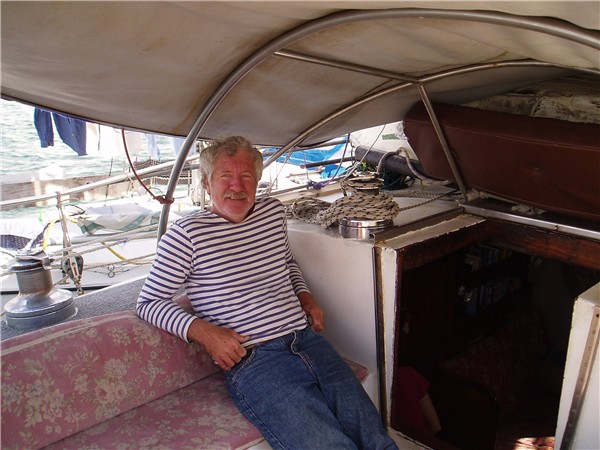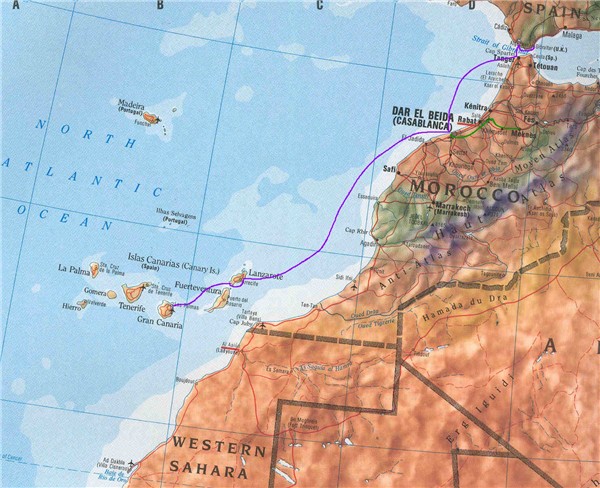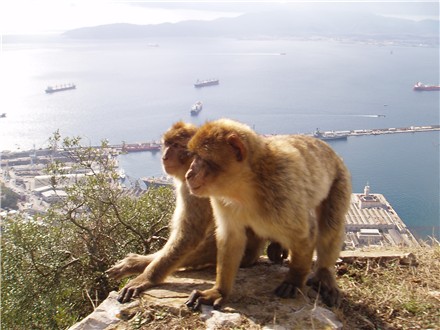FROM GIBRALTAR TO CANARY ISLANDS:
30 DAYS AT SEA (AND LAND)
Ben Ho Jan. 2005
Part 1
Gibraltar
The rendezvous was planned nearly a year ago, to join a sailing trip on a small sailboat I had seen only on a web site, at a port somewhere in Gibraltar, with a crew not yet signed up. Allen Phillips is an Aussie skipper who sails a 44 foot (15 meter) sailboat “Wallaby Creek” with his young family around and around the world. For a modest fee that includes all expenses and meals, he takes a crew of up to four persons on board for month-long trips. No sailing experience needed. On his web site he publishes his itinerary one to two years ahead, stating when and where he will be each month. You pick the dates that you are available, the type of journey that you are interested in – say crossing the pacific, or port hopping at the Med – and you are on. I have some experience sailing a small sailboat and have always wanted to get a taste of an extended sailing voyage in the open ocean, so a November sailing trip from Gibraltar to Canary Islands with stops at Morocco seemed ideal.
On a late Saturday afternoon, after two bus rides and a taxi ride from the airport at Malaga, I finally arrived at the Mediterranean city of Algercira, a short trip to Gibraltar. The temperature at the Spanish coast in this late-fall is similar to that at home in Waterloo, around 10 to 15 degree C. Gibraltar is a rocky peninsula that overlooks the narrow Strait separating continental Europe and Africa, and over the centuries Gibraltar has been hotly contested between Britain and Spain. Today the ‘Rock’ is still British property, and you need a passport to get through the border. After a 45 minute walk, carrying a heavy duffel bag, a backpack and a sleeping bag, I eventually found Wallaby Creek docking among a number of other ocean-going yachts and met up with Allen and his wife, Natalie.

Skipper Allen relaxing in the cockpit of Wallaby Creek
The sailboat Wallaby Creek is a steel-hull boat with
a single mast that runs a mainsail and a headsail. There is a V-berth at
the bow, a toilet, a well-equipped galley with two settees that also services as beds, and a state room in the rear (stern). For
showers, you go for a swim or wait for the rain. Steering is by tiller, but
there are two autopilots that normally can take over once open water is reached.
When the wind dies, there is a diesel engine that provides cruising power.
Navigation is done by a GPS that connects to a laptop computer running a
charting software that provides full details for every single port of sail
reaching every corner in the world. This is not exactly a luxury yacht, but it
is well equipped for ocean-going voyages.
The next day the other crew joined us. Elaine is a young architect from Scotland with an angelic smile. Having worked in Edinburgh for a year, she decided to go travel around the world seeking architectural inspirations, and starting her global-trotting journey with a sailing trip towards warmer climate seemed logical. Natalie, the skipper’s wife, headed back to native Switzerland for a break. So there we were, an Aussie, a Scot, and a Canadian, ready for a month-long trip that would take us to the Morocco ports of Tangier and Casablanca, and then across the African coastal waters of the Atlantic to Canary Islands, a total sailing distance equivalent to, very roughly, going from New York to Florida:

Sailing routes from Gibraltar to Canary
Over the next several days we waited for a passing gale to
blow itself out, so we took the time to tour around Gibraltar. This peaceful
British island-colony is a popular tourist town, with travelers visiting from
continental Europe by car or plan. It is also a favorite stopover point for
cruise ships as part of the Mediterranean – Canary route. Walking through the
old city lined with white-washed buildings, footpaths lead one up the rocky hill
that dominates the city. Heavily fortified over the centuries against sieges,
the Upper Rock of Gibraltar is dotted with gunnery embankments that overlook the
Strait. Large reservoirs were built into solid rock in the mountain, and natural
caves were used as shelters in times of war. The Bay of Gibraltar was a place of
repeated battles between the Dutch, the French, the Spanish and the British in
the 16th and 17th centuries. the Spanish Armada clashed
with the British Navy off the Strait of Gibraltar, and in 1805 Lord Nelson died
in a fierce naval battle in these choppy waters despite winning the battle. The
guns are silent now, and wild monkeys overrun the ruins of forts still guarding
the Strait, looking for handouts from tourists.
The monkeys of Gibraltar
Winding its way around a deserted large naval gun that in its time was one of the most powerful cannons in the known world, the rocky footpath reaches from one side of town to the top of the hill overlooking the Atlantic side of the Strait, and then down the hill to the Mediterranean side. At the top of the hill, under a blue sky, looking South-West one can see beyond the Bay of Gibraltar with Morocco in the distance, and to the East the turquoise blue water of the Mediterranean sea sparkles, with fishing boats dotting the otherwise empty sea in this early-winter month of November.
Top of the Rock
After two days in Gibraltar, we were ready to embark on the trip. The first task was to motor over to the Spanish side to get groceries, as prices there is much better than the tourist shops in Gibraltar. The harbors are all sheltered and we dropped anchor off a beach by a highway in La Linea, and launched the dingy to get to shore. An hour later, returning with a fully loaded grocery cart, we couldn’t find the dingy. All that was left on the tiny beach was track marks indicating that the dingy was dragged off. Wallaby Creek lies about 200 meters away, so close and yet so far. As we were scratching our heads and swearing at the thieves that stole our dingy, an elderly gentleman drove up in a beaten up small car. Through a combination of sign language and bits of English, he told us that the police took the dingy. He lives at a high rise apartment nearby, and he was watching the whole episode. I asked him to drive me to the police station, while the other two stayed with the grocery cart. More head scratching and hand signaling at the police station – they were explaining about us doing something wrong and something about money. Finally a light bulb came on and the officer went to his PC, and used the magical English translator in the word processing software. Basically we landed illegally, and the dingy was impounded! We can get it back, but it would cost 160 Euro (about $320 Canadian) for the ‘service’. Finally, three hours later, a truck showed up and dropped off our dingy at the same place. The Spanish gentleman stayed with us all the time, using his cell phone to make sure that the return was processed through the bureaucracy, refused to take any payment for his help, and at the end only reluctantly accepted a bottle of wine that we took out from our grocery pile. By the time we got back to the dingy, it was too late in the day to start sailing, so we stayed at the anchorage, enjoyed supper made from the bountiful groceries we bought, and watched cargo ships lighting up the harbor as the sun set behind distant mountains.
Return to Ben's Sailing Home Page

